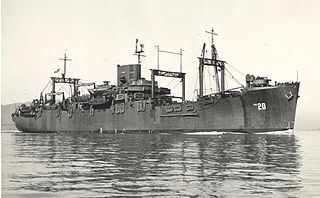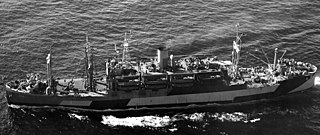
USS Montpelier (CL-57) was one of 27 United States Navy Cleveland-class light cruisers completed during or shortly after World War II. She was the second US Navy ship to be named for the city of Montpelier, Vermont. Montpelier was commissioned in September 1942 and saw service in several campaigns in the Pacific. Like almost all her sister ships, she was decommissioned shortly after the end of the war, and never saw active service again. Montpelier was scrapped in the early 1960s.

USS Conway (DD/DDE-507), a Fletcher-class destroyer, was the second ship of the United States Navy to be named for William Conway, who distinguished himself during the Civil War.

USS Neville (AP-16/APA-9) was a Heywood-class attack transport in service with the United States Navy from 1918 to 1919 and from 1940 to 1946. She was scrapped in 1957.

USS Fuller (AP-14/APA-7) was a Heywood-class attack transport in service with the United States Navy from 1941 to 1946. She was scrapped in 1957.

USS Libra (AK-53/AKA-12/LKA-12) was an Arcturus-class attack cargo ship named after the constellation Libra. She served as a commissioned ship for 11 years.

USS Refuge (AH-11), was a hospital ship of the United States Navy during World War II. The ship was built in 1921 by the New York Shipbuilding Corp., of Camden, New Jersey, as SS Blue Hen State, but was renamed President Garfield in 1923 and then SS President Madison in 1940 for service with American President Lines. Acquired by the Navy from the War Shipping Administration on 11 April 1942 the ship was commissioned as the transport USS Kenmore until conversion to a hospital ship.

USS Wharton (AP-7) was a troop transport in the service of the United States Navy during World War II. The ship was originally an Emergency Fleet Corporation Design 1029 type built for the United States Shipping Board. The ship was laid down as Manmasco but renamed and launched as Sea Girt then completed September 1921 as Southern Cross. The ship was first allocated by the United States Shipping Board to the Munson Steamship Line until purchased by the line in 1925. Munson operated the Southern Cross in the South American trade from 1921 until 1938 when the ship was sold at a Marshall's sale and taken over by the United States Maritime Commission which paid the full mortgage claim.

USS President Hayes (APA-20) was a President Jackson-class attack transport that saw service with the US Navy in World War II. It was named for Rutherford B. Hayes, 19th U.S. president.

USS Harry Lee (APA-10) was a Harry Lee-class attack transport that saw service with the US Navy during World War II. She served in the Pacific War, as well as in North Atlantic Ocean operations, and safely returned home post-war with seven battle stars to her credit. She was the only ship in her class.

USS Cor Caroli (AK-91) was a Crater-class cargo ship commissioned by the US Navy for service in World War II and manned by a US Coast Guard crew. She was named after Cor Caroli, the brightest star in constellation Canes Venatici. She was responsible for delivering goods and equipment to locations in the war zone.

USS Ormsby (APA-49) was an Ormsby-class attack transport that served with the US Navy from 1943 to 1946. She was subsequently sold into commercial service and was scrapped in 1969.

USS Crescent City (AP-40/APA-21) was the lead ship of the Crescent City-class attack transports that served with the US Navy during World War II. The ship was built as the cargo and passenger liner Delorleans for the Mississippi Shipping Company's Delta Line. After brief commercial operation the ship was among 28 vessels requisitioned in June 1941 for the Navy and the Army. The Navy renamed the ship Crescent City, a popular nickname for New Orleans, Louisiana, upon commissioning 10 October 1941. The ship was decommissioned and laid up in 1948 before being loaned to the California Maritime Academy to serve as a training ship 1971–1995 and then transferred to a foundation in a failed art colony project. The ship left California for Texas scrapping in 2012.

American Legion was built for the United States Shipping Board (USSB), one of the planned World War I troop transports converted before construction into passenger and cargo vessels, the Emergency Fleet Corporation Design 1029 ships. The ship was laid down as Koda and perhaps assigned the name Badger State at one point, but renamed American Legion before launch and one of only a few of the design not taking a state nickname. Originally operated by the USSB's agents and the Munson Steamship Line the ship saw commercial service until laid up 13 March 1939.

USS Harris (APA-2) was an Emergency Fleet Corporation Design 1029 ship launched for the United States Shipping Board (USSB) on 19 March 1921 by Bethlehem Shipbuilding Corporation, at Sparrows Point, Maryland as Pine Tree State. After operation by commercial lines for the USSB, during which the ship was renamed President Grant and operated commercially until laid up in the late 1930s.

USS Zeilin (APA-3) was an Emergency Fleet Corporation Design 1029 ship launched for the United States Shipping Board (USSB) on 19 March 1921 by Newport News Shipbuilding and Drydock Company in Newport News, Virginia as Silver State. After operation by commercial lines for the USSB, during which the ship was renamed President Jackson, the ship was purchased and operated commercially until laid up in the late 1930s.

USS Leonard Wood (APA-12) was built by Bethlehem Shipbuilding Corporation and launched 17 September 1921 at Sparrows Point, Maryland as Nutmeg State, an Emergency Fleet Corporation Design 1029 ship intended as a World War I troop transport, but redesigned upon the armistice as a passenger and cargo ship and completed as Western World for delivery to the United States Shipping Board. The ship's acceptance on 5 May 1922 and delivery on 9 May 1922 marked the completion of the wartime shipbuilding program of the Emergency Fleet Corporation and the Shipping Board.

USS Henry T. Allen was a Harris class attack transport in service with the United States Army from 1940 to 1941. She was then transferred to the United States Navy where she served until 1946. She was scrapped in 1948. The ship was originally built as a Emergency Fleet Corporation Design 1029 ship in 1919 and operated in commercial service as Wenatchee and President Jefferson until being laid up in 1938.

USS J. Franklin Bell (APA-16) was a Harris-class attack transport ship. She was built in 1921 and spent 20 years in merchant service as a passenger and cargo liner. She was acquired for the United States Army in 1940 and transferred to the United States Navy shortly after the USA entered the Second World War. She served throughout and after the Pacific War, was decommissioned in 1946 and scrapped in 1948.

USS Barnett (APA-5) was a McCawley-class attack transport that served with the US Navy during World War II.

USS President Adams (AP-38/APA-19) was a President Jackson-class attack transport of the United States Navy, named for Founding Father John Adams and his son, John Quincy Adams, the second and sixth Presidents of the United States.




















